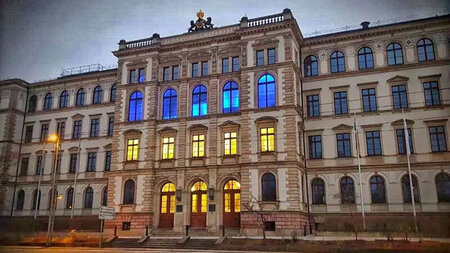Amorphous magnetic phases and spin glasses
Although magnetism is often treated in some sort of lattice model, a crystalline lattice is no prerequisite for ferromagnetism, pointed out by Gubanov in 1960. And indeed there are even several classes of amorphous metals which show ferromagnetism.
In crstalline materials, the appearance of defects and grain boundaries contributes or even governs the mechanisms of magnetization reversal. Defects can act as nucleation sites for domain walls – assisting the reversal process –, but even more often as pinning sites, impeding the propagation of domain walls and thereby impeding the magnetization reversal. So, the entire absence of a crystalline order – as in amorphous metals – allows the production of materials with very low coercivity.
Magnetocrystalline anisotropy terms, however, will even exist in the amorphous state – but their direction varies now locally at random. More than thirty years ago, Harris, Plischke and Zuckermann formulated an Hamiltonian for this system,
![]() ,
,
(Vi the single ion anisotropy, J(i) the spin operator, I the Heisenberg coupling constant), a Heisenberg-like system with an added local, random anisotropy.
It was later found, that even a weak local random anisotropy should be enough to entirely destabilize ferromagnetism, if there is not a (even weak) global anisotropy. The Harris-Plischke-Zuckermann model has been mostly used for rare earth compound, like the Fe2Tb for which it was originally developed, and most theoretical work has dealt with the limit of strong local anisotropy.
Under certain circumstances, strong local anisotropy can lead to a freezing of the magnetic system, as a spin glass (we use this term rather generic, without the distinction between cluster and spin glasses) [3].
There are furthermore metallic glasses using only 3d ferromagnetic metals, which, due to their itinerant magnetisation, cannot completely be described in the Heisenberg picture.
The 3d transition metals can be amorphized by alloying with either a metalloid (boron or phosphorous) or with an early transition metal (zirconium or yttrium). The glass forming ability is better for ternary systems, like FeCoB (which is often used as an extremely soft magnetic material, also for tunnel junctions) or FeCoZr than for the binaries FeB or FeZr.
FeZr is especially interesting, as the frustration by the local anisotropies can, in a certain concentration range, lead to two magnetic phase transitions. At high temperatures, the system is paramagnetic, at temperatures of roughly 200 K (for 10% Zr) the material becomes ferromagnetic, and at very low temperatures it forms a so-called reentrant spin glass.
This material combination has shown a exceedingly rich magnetic behavior – ferromagnetism, antiferromagnetism, and for lower iron concentrations even superconductivitiy has been reported. The magnetic microstructure of the ferromagnetic phase has long been controversial [4], models have ranged from ferromagnetic clusters in a ferromagnetic matrix to wandering axis ferromagnets. For thin films in some concentrations, even an out-of plane magnetization has been reported [5]. Counter-intuitive as an out-of-plane anisotropy would seem, it has already known for some time for films of transition metal-rare earth compounds like the above mentioned Fe2Tb.
Although an enormous amount of work was done on this systems starting from the seventies, there is still a surprising amount of open questions. Band structure calculations are difficult, since no reciprocal basis exists, and the parameter space for tayloring magnetic properties becomes even larger when one includes partial crystallization [6].
Starting from the work about partial crystallization in iron-zirconium layers, our own work – in collaboration with the group of Björgvin Hjörvarsson in Uppsala, Sweden (http://material.fysik.uu.se) – is concerned with the influence of finite thickness effects on the two phase transitions in the iron zirconium system. For very low thicknesses, it behaves similarly to an 2D XY system, although modified by the random anisotropy terms.
Another
field of study are the iron-terbium compounds. The terbium carries a
strong magnetic moment itself, antiferromagnetically coupled to that
of the iron. Since the temperature dependence of the magnetization is
very different for iron and terbium, at low temperatures the terbium
moment dominates, at high temperatures the iron moment, while there
is a point at which the material appears as an antiferromagnet
without any global moment. Here we are mainly interested in
heterostructures of amorphous iron-terbium and crystalline iron
zirconium.

References:
[1]
Gubanov, A. I., Sov. Phys. Solid State 2(1961)468
[2] Harris, A., Plischke, M., Zuckermann, M. J.: New model for amorphous magnetism, Phys. Rev. Lett. 31, 160, 1973
[3] Binder, K., Young, A. P.: Spin glasses: Experimental facts, theoretical concepts, and open questions, Rev. Mod. Phys. 58(4) 801–976, 1986
[4] Calderon, R. Garcia, Barquin, L. Fernandez, Kaul, S. N., Sal, J. C. Gomez, Gorria, Pedro, Pedersen, J. S., Heenan, R. K.: Small-angle neutron scattering study of a magnetically inhomogeneous amorphous alloy with reentrant behavior, Phys. Rev. B 71(13), 134413, 2005
[5] Sharma, P., Kimura, H., Inoue, A.: Magnetic behavior of cosputtered Fe-Zr amorphous thin films exhibiting perpendicular magnetic anisotropy, Phys. Rev. B (Condensed Matter and Materials Physics) 78(13), 134414, 2008
[6] Liebig, A., Korelis, P. T., Lidbaum, H., Andersson, G., Leifer, K., and Hjörvarsson, B.: Morphology of amorphous Fe91Zr9/Al2O3 multilayers: Dewetting and crystallization, Phys. Rev. B 75(21)214202, 2007





